The early wear susceptibility of dentine following exposure to citric acid: In vitro study
IF 2.1
4区 医学
Q2 DENTISTRY, ORAL SURGERY & MEDICINE
引用次数: 0
Abstract
Objective
This study investigated the effect of early erosion on the mechanical and structural properties of dentine, while comparing the influence of different citric acid pH and concentration levels.
Design
Twenty dentine specimens were randomly allocated into five groups, according to the citric acid (CA) solution: non-eroded; 1 % buffered CA (pH=3.8); 1 % unbuffered CA (pH=2.55); 6 % buffered CA (pH=3.8); and 6 % unbuffered CA (pH=2.06). Specimen numbers were determined from a sample size power calculation. Erosion groups were subjected to 6x cycles, each lasting 20 s, giving a total exposure of 2 min. Surface alterations were determined by atomic force microscopy (at nanoscale) after each cycle. Erosive changes were also assessed qualitatively/quantitatively with scanning electron microscopy and energy dispersive x-ray spectroscopy. Data were analysed by repeated measures ANOVA with Bonferroni correction.
Results
All erosion groups showed significant structural and mechanical changes after a 20 s exposure interval. Specimens exposed to 6 % unbuffered CA, revealed a significant reduction of modulus of elasticity (p < 0.01), and greater changes to topography and morphology, compared with other groups. The 1 % buffered group had the least erosive changes (p < 0.05). Dentine exposed to 1 % unbuffered CA had a comparably greater rate of erosion, compared with the 6 % buffered solution, as exposure times progressed.
Conclusions
Dentine was highly susceptible to early CA erosion, with significant changes occurring after 20 s, regardless of pH or concentration. Alterations to the pH and/or concentration significantly altered the rate and severity of erosion. Although, CA with a lower pH was the most critical factor for early dentine erosion.
柠檬酸对牙本质早期磨损敏感性的体外研究
目的探讨早期侵蚀对牙本质力学和结构性能的影响,并比较不同柠檬酸pH和浓度对牙本质力学和结构性能的影响。设计将20个牙本质标本随机分为五组,根据柠檬酸(CA)溶液分为:未腐蚀组;1 %缓冲CA (pH=3.8);1 %未缓冲CA (pH=2.55);6 %缓冲CA (pH=3.8);6 %未缓冲CA (pH=2.06)。样本数量由样本容量功率计算确定。侵蚀组进行6次循环,每次持续20 s,总暴露时间为2 min。每个循环后,通过原子力显微镜(纳米级)测定表面变化。利用扫描电子显微镜和能量色散x射线能谱对侵蚀变化进行定性/定量评估。数据分析采用Bonferroni校正的重复测量方差分析。结果各侵蚀组在20 s的暴露时间后均出现了明显的结构和力学变化。与其他组相比,暴露于6 %无缓冲CA的标本显示弹性模量显著降低(p <; 0.01),地形和形态变化更大。1 %缓冲组糜烂变化最小(p <; 0.05)。随着暴露时间的推移,暴露于1 %未缓冲CA的牙本质比暴露于6 %缓冲溶液的牙本质有更大的侵蚀率。结论牙本质对早期CA侵蚀非常敏感,在20 s后发生显著变化,与pH和浓度无关。pH值和/或浓度的改变显著改变了侵蚀的速率和严重程度。然而,较低pH的CA是早期牙本质侵蚀的最关键因素。
本文章由计算机程序翻译,如有差异,请以英文原文为准。
求助全文
约1分钟内获得全文
求助全文
来源期刊

Archives of oral biology
医学-牙科与口腔外科
CiteScore
5.10
自引率
3.30%
发文量
177
审稿时长
26 days
期刊介绍:
Archives of Oral Biology is an international journal which aims to publish papers of the highest scientific quality in the oral and craniofacial sciences. The journal is particularly interested in research which advances knowledge in the mechanisms of craniofacial development and disease, including:
Cell and molecular biology
Molecular genetics
Immunology
Pathogenesis
Cellular microbiology
Embryology
Syndromology
Forensic dentistry
 求助内容:
求助内容: 应助结果提醒方式:
应助结果提醒方式:


